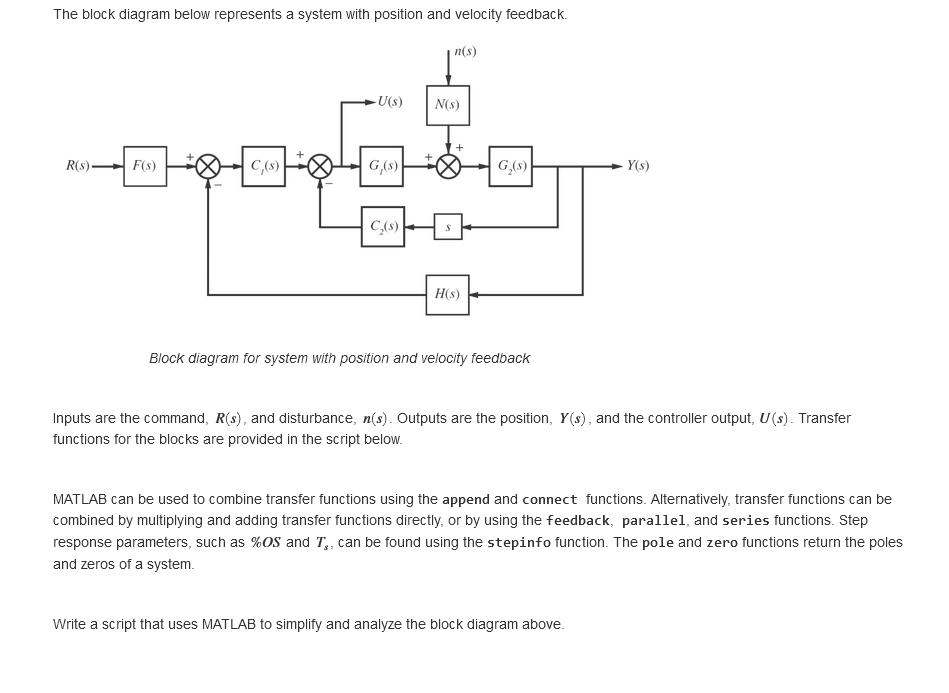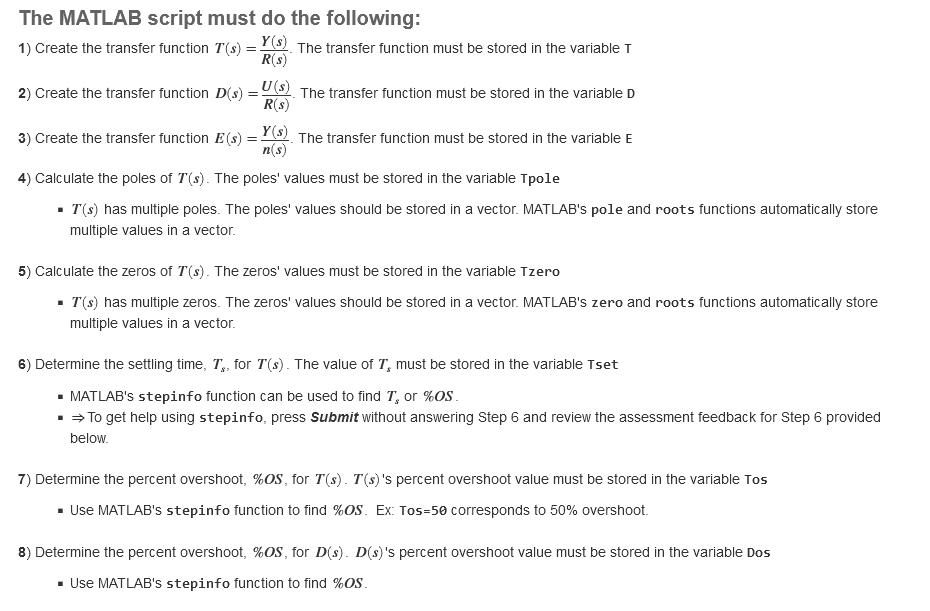Answered step by step
Verified Expert Solution
Question
1 Approved Answer
The block diagram below represents a system with position and velocity feedback. R(s)- F(s) C,(s) -U(s) G,(s) C(S) n(s) N(S) S H(s) G,(s) Block



The block diagram below represents a system with position and velocity feedback. R(s)- F(s) C,(s) -U(s) G,(s) C(S) n(s) N(S) S H(s) G,(s) Block diagram for system with position and velocity feedback - Y(s) Inputs are the command, R(s), and disturbance, n(s). Outputs are the position, Y(s), and the controller output, U(s). Transfer functions for the blocks are provided in the script below. MATLAB can be used to combine transfer functions using the append and connect functions. Alternatively, transfer functions can be combined by multiplying and adding transfer functions directly, or by using the feedback, parallel, and series functions. Step response parameters, such as %OS and T,, can be found using the stepinfo function. The pole and zero functions return the poles and zeros of a system. Write a script that uses MATLAB to simplify and analyze the block diagram above. The MATLAB script must do the following: 1) Create the transfer function 7 (s) = Y(s). The transfer function must be stored in the variable T R(s) 2) Create the transfer function D(s)=(s) The transfer function must be stored in the variable D R(s) 3) Create the transfer function E(s) = Y(s). The transfer function must be stored in the variable E n(s) 4) Calculate the poles of T(s). The poles' values must be stored in the variable Tpole T(s) has multiple poles. The poles' values should be stored in a vector. MATLAB's pole and roots functions automatically store multiple values in a vector. 5) Calculate the zeros of T(s). The zeros' values must be stored in the variable Tzero T(s) has multiple zeros. The zeros' values should be stored in a vector. MATLAB's zero and roots functions automatically store multiple values in a vector. 6) Determine the settling time, T., for T(s). The value of T, must be stored in the variable Tset MATLAB's stepinfo function can be used to find T, or %OS. To get help using stepinfo, press Submit without answering Step 6 and review the assessment feedback for Step 6 provided below. 7) Determine the percent overshoot, %OS, for T(s). T(s)'s percent overshoot value must be stored in the variable Tos Use MATLAB's stepinfo function to find %OS. Ex: Tos-50 corresponds to 50% overshoot. 8) Determine the percent overshoot, % OS, for D(s). D(s)'s percent overshoot value must be stored in the variable Dos Use MATLAB's stepinfo function to find %OS. 1% clear; close all; % clear all variables and graphs 2% include when using the desktop version of MATLAB. clear and close all are not needed in MATLAB Grader online. 3 % 4 format compact; % removes extra lines in the output 5 6% System transfer functions 7 F=tf(2,1); 8 G1-tf(2, [1 4]); 9 G2= tf([8*8],[1 2*0.8*8 8*8 ]); 10 C2-tf(20, [1 20]); 11 S1-tf(1,1); % a unity transfer function, that can be used if needed 12 C1-tf([55], [110]); 13 H=tf(30, [1 30]); 14 N=tf(50, [1 100]);
Step by Step Solution
★★★★★
3.44 Rating (163 Votes )
There are 3 Steps involved in it
Step: 1
To solve these tasks in MATLAB we need to use the provided system transfer functions and apply the block diagram reduction rules to find the closedloo...
Get Instant Access to Expert-Tailored Solutions
See step-by-step solutions with expert insights and AI powered tools for academic success
Step: 2

Step: 3

Ace Your Homework with AI
Get the answers you need in no time with our AI-driven, step-by-step assistance
Get Started


